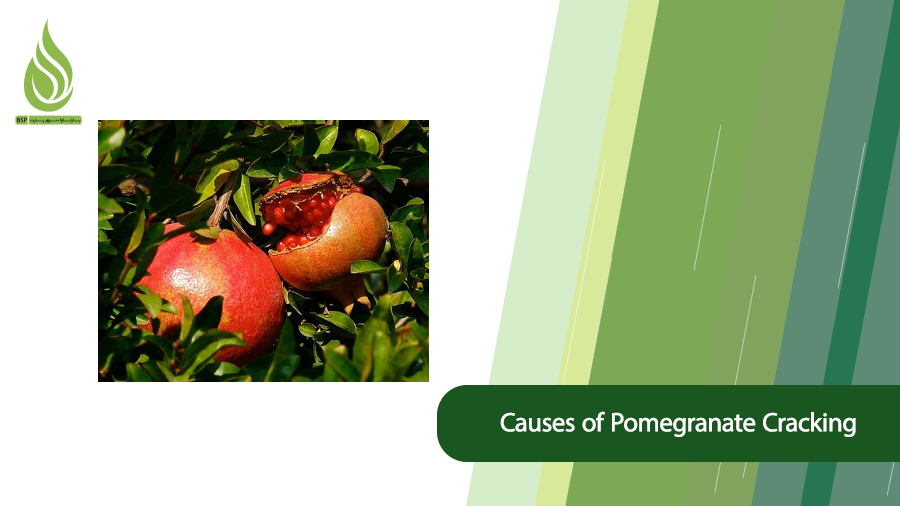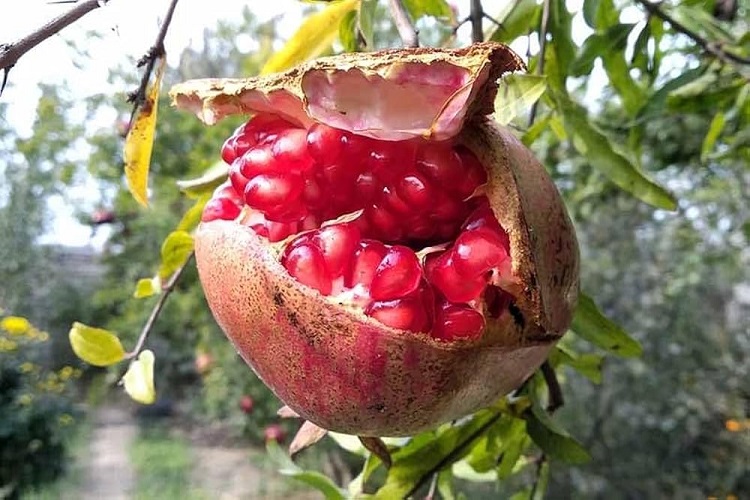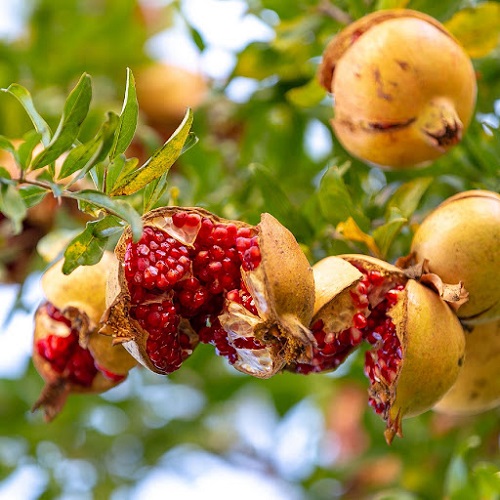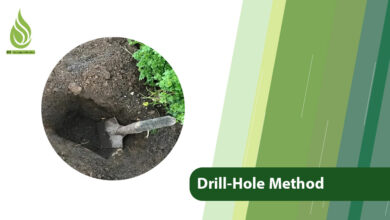
Causes of Pomegranate Cracking and Prevention Strategies
Pomegranates are a beloved and nutrient-rich fruit cultivated in many countries, including our own. One of the most common challenges in pomegranate cultivation is fruit cracking, where the skin of the pomegranate splits open while still on the tree, exposing the inner seeds. This issue can stem from various factors, such as unfavorable soil conditions, nutrient deficiencies, and more. In this article, we’ll explore the primary causes of pomegranate cracking and provide effective strategies to prevent it. By understanding these factors and following key practices, you can harvest healthy, high-quality pomegranates and enjoy a more successful growing experience.
Causes of Pomegranate Cracking
Pomegranate cracking or splitting can result from a variety of factors. Below, we outline the main reasons behind this issue:
Water Stress
One of the leading causes of fruit cracking is water stress, often due to irregular irrigation schedules. When irrigation is delayed, pomegranates gradually lose moisture, causing the skin to lose its elasticity. When watering resumes, the seeds swell, but the dried-out skin cannot accommodate the expansion, leading to cracks.
Nutrient Deficiencies
A lack of essential nutrients, such as potassium, calcium, zinc, and boron, can weaken the cell walls of pomegranates, making them prone to cracking. Poor tree nutrition results in brittle fruit skin, increasing the likelihood of splitting. Regular fertilization during the growing season can address nutrient deficiencies and help prevent cracking.

Improper Irrigation
Irrigation must be consistent and balanced. Both under-watering and over-watering can cause pomegranates to crack. Trees in hot climates require more frequent watering to meet their needs.
Hot, Dry Winds
Strong, hot winds are another contributor to pomegranate cracking. These winds accelerate moisture evaporation from the tree, leaving the fruit dehydrated. As the skin dries out, it becomes susceptible to splitting when water is reintroduced.
Pests and Diseases
Pests or diseases can weaken pomegranates, making them more likely to crack. Pests like aphids and mites feed on plant cells, compromising the tree’s health and potentially spreading diseases that affect fruit integrity.
Excessive Fruit Load
Overbearing trees, where too many fruits develop, place undue pressure on individual pomegranates, which can lead to cracking. To mitigate this, farmers often prune excess branches and remove weak or surplus fruit during the fruiting season, allowing the tree to focus its energy on producing healthy fruit.
Overgrowth of Pomegranates
While nutrient deficiencies can harm fruit, excessive fertilization is equally problematic. Over-fertilizing disrupts the nutrient balance, sometimes causing pomegranates to grow too large. This overgrowth can stretch the skin beyond its capacity, resulting in cracks.
Temperature Fluctuations
Pomegranate trees are generally resilient to high temperatures, but drastic swings from cool to hot conditions can damage fruit. In desert regions, where nighttime temperatures drop sharply and daytime temperatures soar to 104°F (40°C), cracking is more prevalent.
Strategies to Prevent Pomegranate Cracking
To prevent pomegranate cracking, consider implementing the following practices:
Planting Resistant Varieties
Different pomegranate varieties have unique physiological traits. Some are more sensitive to temperature changes or environmental stressors. Choosing a variety suited to your region’s climate and conditions can help minimize issues like cracking.

Regular and Balanced Irrigation
Irregular watering is a key cause of cracking. Consistent, balanced irrigation is critical to preventing this problem. Develop a precise watering schedule, ideally using deep irrigation to ensure moisture reaches deeper soil layers. In dry conditions, water pomegranate trees every 7–10 days. Maintaining soil moisture, especially in late summer and early fruit development, reduces the risk of cracking. Water in the early morning or late afternoon to minimize moisture fluctuations, and avoid sudden, heavy watering, which can cause rapid fruit expansion and splitting. Using mulch around the base of trees helps retain soil moisture and reduce evaporation.
Managing Fruit Load
Proper pruning helps distribute the fruit load evenly across the tree. Additionally, thinning out weak or excess fruit encourages the development of higher-quality pomegranates.
Pest and Disease Control
Regularly inspect trees for signs of pests or diseases and use organic control methods whenever possible. If necessary, apply natural pesticides or non-chemical solutions to manage infestations.
Timely Harvesting
Harvest pomegranates at the right time. Delayed harvesting increases the risk of cracking, as overripe fruit is more prone to splitting.
Proper Drainage
Ensure the soil has good drainage to prevent waterlogging, which can stress the tree and contribute to fruit cracking.
Protection Against Temperature Fluctuations
Preventing cracking due to temperature swings can be challenging. In areas of the orchard exposed to intense sunlight, installing shade structures during the hottest months can mitigate the sun’s harsh effects. In colder conditions, covering trees or lighting small fires in the orchard can help protect against extreme cold. Proper irrigation also plays a role in reducing the impact of temperature-related cracking.
By following these practices, you can effectively prevent pomegranate cracking and produce healthy, high-quality fruit.
The Role of Fertilization in Preventing Pomegranate Cracking

To achieve optimal growth, pomegranate trees require a range of nutrients through fertilization. These nutrients come from both organic and mineral fertilizers. Deficiencies in key elements like potassium, calcium, boron, and zinc can lead to fruit skin splitting. These nutrients not only strengthen the tree and boost yield but also help prevent cracking.
Once fruit begins to crack, addressing soil deficiencies or supplying nutrients to the tree is often too late. Preventive measures must be taken during various growth stages before cracking occurs. Potassium and calcium deficiencies, for instance, can cause fruit discoloration, followed by skin cracking.
To determine the tree’s nutrient needs, conduct a soil test, ideally in late winter before the growing season begins. This provides insight into the soil’s condition and informs a tailored fertilization plan. Over-fertilization can harm trees, so precision is key.
Some farmers use ash and salt to supply calcium and potassium to pomegranate trees. Salt contains potassium and calcium, which support root development. Farmers often mix salt with fertilizer and apply it around the tree’s base. Ash, rich in calcium, potassium, and phosphorus, offers antifungal and insect-repellent properties. Adding ash to the soil helps retain moisture, reducing the need for frequent watering.
Timing Nitrogen Fertilization
One critical aspect of fertilizing pomegranate trees is the timely application of nitrogen-based fertilizers. Nitrogen fertilizers promote branch and leaf growth, which are essential for tree health. However, their use must be carefully timed. Once pomegranates reach the “walnut” stage (early fruit formation), nitrogen fertilization should be halted. The best time to apply nitrogen is in late winter, during bud break, to support early-season growth.
By implementing these fertilization strategies, you can address nutrient deficiencies, strengthen your trees, and significantly reduce the likelihood of pomegranate cracking.
